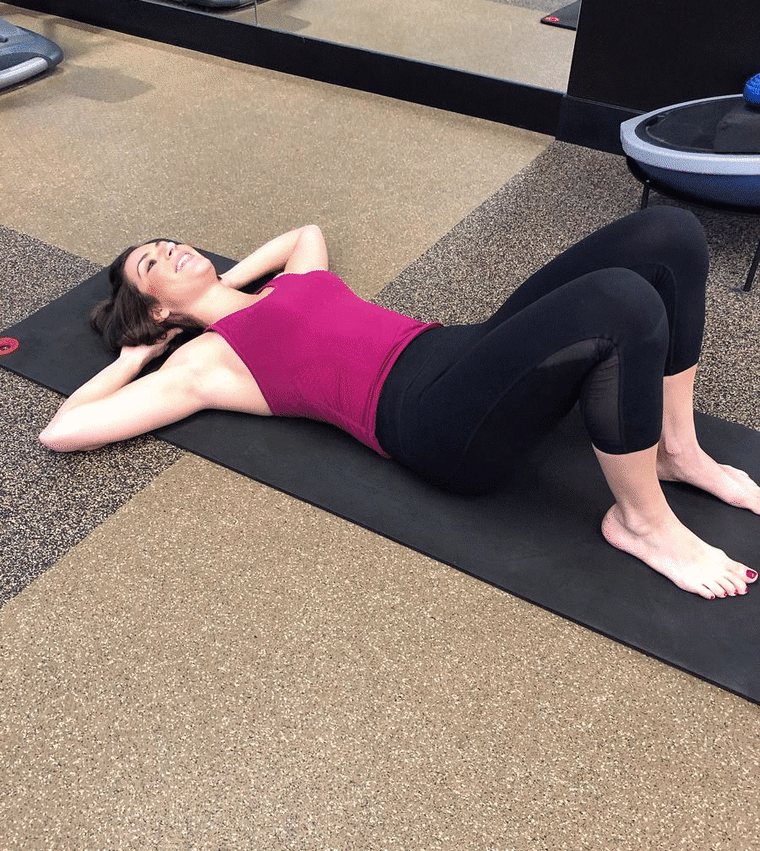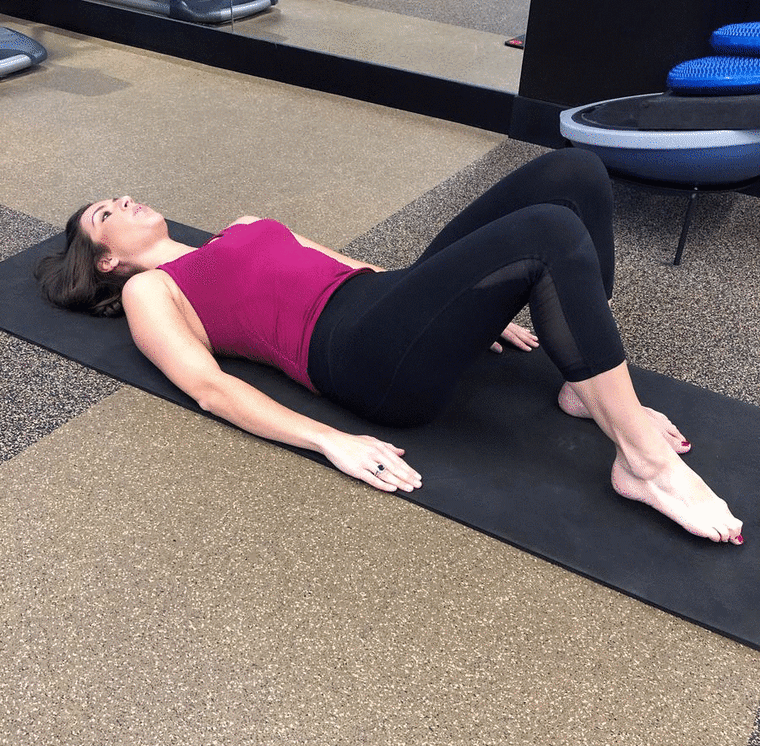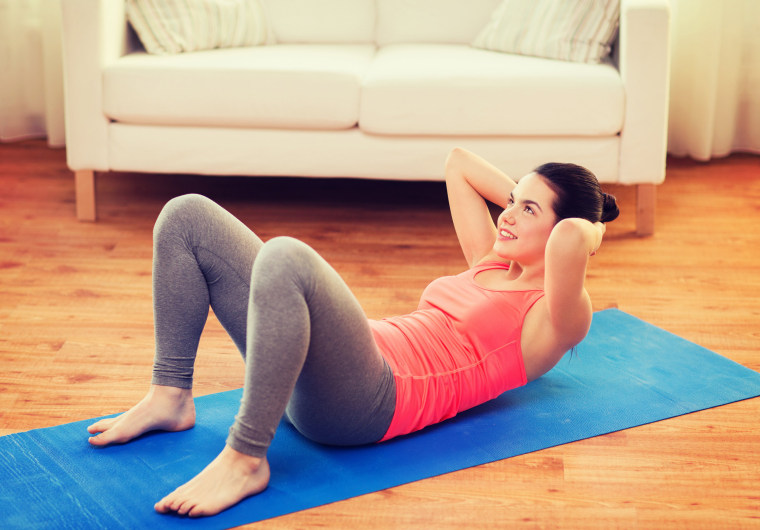One of the most common complaints about traditional abdominal exercises is neck or back pain. If you’re one of these people you may wonder whether you should you throw in the towel or push through despite the discomfort.
As a personal trainer and coach, I hear this complaint often and it tends to boil down to a handful of causes, all which are related to improper form. Here are the top three reasons why ab exercises may be aggravating your neck and your back — plus, a few fixes you can use in the moment to protect your neck and back, reduce pain and lower your risk of injury.
Mistake #1: You’re Pulling From Your Neck, Not Your Abs
Even though ab exercises are supposed to be all about your core, many positions require your head and neck to lift up off of the ground. Jonathan Tylicki, director of education for AKT and certified personal trainer, says that the strain you may feel in your neck in this position is most likely related to your posture. “The continued neck flexion is associated with sitting, working at a computer, and texting. This reinforced improper alignment can creep up when you are doing ab work, making you pull your head forward and use your neck during exercises,” he says. When you’re in a supine position on your back, typically you’ll rest your head in your hands and then curl up, lifting your head and neck off the mat. This can cause discomfort, particularly if your posture muscles are tight and you’re not used to engaging your core correctly.
- Fix #1: Work with your tongue. Try this simple hack from Phil Timmons, Blink Fitness program manager. “Press your tongue on the roof of your mouth and up against your front teeth.” He explains that placing your tongue on the roof of your mouth and just behind your front teeth applying some pressure with your tongue engages deeper neck muscles and increases muscular support.
- Fix #2: Train from different angles. Tylicki suggests exercises like planks, oblique v-ups, c-curve holds, and prone back extensions, as well as other exercises from a standing, rotational and seated position. “You should incorporate core work that engages all aspects of your abdominal complex,” he says.
But what if you’re in a Pilates or core class and don’t want to be the odd one out doing your own routine?
- Fix #3: Use a workout towel. Tylicki says to take a towel behind your head and grab each end with your hands. “When you lift to crunch, be sure to relax your head into the towel — don't let any tightness creep into your neck. This is a great way to relax the muscles of your neck, and bring the focus of the exercise to your abs. You also get a burn in your arms from holding the weight of your head in the towel!”
Mistake #2: Your Arms Are Doing the Work Instead of Your Core
What if your arms are doing too much work? Specifically, if you’re not using a towel and instead you’re placing your hands behind your head, it's important to remember that this should not be an arm workout. Your arms and hands are simply supporting your neck. But a major mistake people make is engaging the arms instead of the abs.
Trainer Kristina Alai, certified fitness trainer at The Bay Club Company, says that while doing exercises like crunches, you may be overcompensating by grabbing your neck with your hands instead of focusing on the ab engagement. Liana Hughes, certified personal trainer and coach for the fitness app Gixo, says, “It’s very common for people to want to pull their neck when they have their fingertips behind their head.” For many. it’s an automatic action that we do without even noticing, so even if you don't think this applies to you, it can be smart to keep these two tips in mind:
- Fix #1: Slow down. Alai says that some people try to go fast just to get the workout done quickly. She says, “This results in a jolting and jerking motion instead of taking your time through an exercise.” Essentially you’re trying to retrain your body and your brain to initiate the movement from your abs rather than your head, neck and arms. This can take time.
- Fix #2: Focus on where your movement is coming from. It may sounds obvious, but “you actually want to initiate movement from your abs when doing ab exercises," says Hughes. "Gently resting your head in your fingertips, think about your form as you are doing the move.”
Mistake #3: You’re Using Your Back, Not Your Core
As a Pilates instructor, I see so many people using their back instead of their abs to do abdominal exercises. This is concerning because when done incorrectly it can lead to a lower back injury. That’s why it’s important to laser focus in on the transverse abdominis, the deepest ab muscle, to ensure the low back is not overworking in core exercises. This is most common in exercises where your legs are extended or straight. When done correctly, it should feel challenging to keep your core engaged and you will feel this deep in your core muscles (and not so much in your back.) But how can you ensure you have the proper engagement?
- Fix #1: Reduce the range of motion. When your legs are up in the air for ab exercises, whether you’re moving laterally or side to side, cut the range of motion by 50 percent. By forcing yourself to use smaller movements, you’re able to ensure that your abs do the work and your back stays connected to the floor.
- Fix #2: Place your hands under your butt. “For extended leg moves, try sliding your hands under your butt to keep your low back on the ground and pain free and focus on breathing; try moving your limbs on the exhale when your core is naturally bracing and you may find this helps as well,” Hughes recommends.
These Pilates-based Abdominal Exercises Can Ease the Pain
Finally, check out these three suggested moves — they're a great way to reset mid-workout so that the pain doesn’t persist and cause a bigger issue. These basic Pilates exercises are meant for beginners, but are good modifications for all of us to to keep in mind when pain creeps up during exercise. They will also train you to do a proper abdominal crunch while lying down without straining your neck or back, so adding them into your workout routine consistently will help improve your form over time.
The Basic Pilates Crunch

Lying down on the floor, bend your knees and keep your feet flat on the mat. Place your hands behind your head, and rest your head in your hands. Take a deep breath in, and then exhale as you pull your naval in towards your spine. Pull your lower ribs down towards your hips, and from this core engagement you can curl up so that your head and hands are off the ground. Exhale as you curl up, and inhale as you lower back down. Repeat this 10 times.
Pilates Toe Taps

On the mat with your feet flat on the ground, take a deep breath in. Then exhale as you draw your naval in towards your spine, slowly bring your right knee up to a table top position. Draw your lower ribs down towards your hips, and tighten your core as if you were wearing a corset. From here, lower the right leg down to tap the toe onto the ground while maintaining the engagement of the core. There should be no movement above the hips, and the back should stay gently pressing into the ground while the abs are pulling in tightly. Exhale as you lower the leg down, and inhale to bring it back up. Repeat 10 times and then switch to the left side.
Pilates Lower & Lift
Lying on the mat, bring your legs straight up towards the ceiling. Tilt your pelvis so that your lower abs pull in (as if you are zipping into a tight pair of jeans) and your back presses gently into the ground. Maintain this core engagement as you exhale and lower the legs down a few inches towards the ground. Inhale to bring them back up. Be sure to keep your back connected to the mat throughout the entire exercise by drawing your naval in towards your spine.
More ways to prevent neck and back pain
- 4 exercises to combat 'text neck'
- How to prevent neck and back pain when traveling
- Grab a tennis a ball: These 5 desk exercises can help relieve neck and back pain
- Have a bad back? Here's how to move past the fear of exercise
- Perfect your plank: The move to banish back pain
Want more tips like these? NBC News BETTER is obsessed with finding easier, healthier and smarter ways to live. Sign up for our newsletter and follow us on Facebook, Twitter and Instagram.

